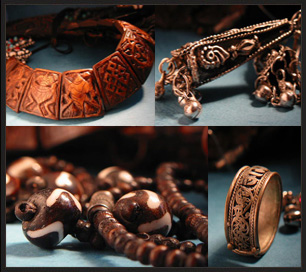|
swastika, swastika symbol, swastika meaning, swastika tattoo, origin of the swastika, swastika history, tibetan swastika, buddhist swastika, swastika in buddhism, swastika buddhism, lama nazibuddhist nazi, nazi tibet
Tibet Artwork, Tibetan Silver Jewelry , Tibetan Jewelry, Tibet Jewelry, Jewelry from Tibet, Tibetan Buddhist Jewelry, Tibetan Turquoise Jewelry, Tibetan Jewelery, Buddhist Jewelry
|
In Hinduism, the right-hand (clockwise) swastika is a symbol of the sun and the god Vishnu, while the left-hand (counterclockwise) swastika represents Kali and magic. The Buddhist swastika is almost always clockwise, while the swastika adopted by the Nazis (many of whom had occult interests) is counterclockwise.
In Buddhism, the swastika signifies auspiciousness and good fortune as well as the Buddha's footprints and the Buddha's heart. The swastika is said to contain the whole mind of the Buddha and can often be found imprinted on the chest, feet or palms of Buddha images. It is also the first of the 65 auspicious symbols on the footprint of the Buddha.
The swastika has also often been used to mark the beginning of Buddhist texts. In China and Japan, the Buddhist swastika was seen as a symbol of plurality, eternity, abundance, prosperity and long life.
The swastika is used as an auspicious mark on Buddhist temples and is especially common in Korea. It can often be seen on the decorative borders around paintings, altar cloths and banners. In Tibetan Buddhism, it is also used as a clothing decoration.
Label: swastika, swastika symbol, swastika meaning, swastika tattoo, origin of the swastika, swastika history, tibetan swastika, buddhist swastika, swastika in buddhism, swastika buddhism, lama nazibuddhist nazi, nazi tibet
|
Buddhist Symbols
In the earliest centuries of Buddhism, statues of the Buddha were not used. Instead, Buddhist art consisted of images symbolizing the Buddha and his teachings, such as the lotus, the Wheel of the Law, the Bodhi tree and the Buddha's footprints.
Eventually, the Buddha image became one of the most popular representations in Buddhism, but these early symbols remain important and are frequently used to this day. They are especially important in Theravada Buddhist countries like Sri Lanka and Thailand.
As Buddhism spread, Buddhist symbolism was enriched by the cultures it came into contact with. This is especially true of Buddhism in Tibet, which has developed a rich symbolic tradition. The central symbols of Tibetan Buddhism are the Eight Auspicious Symbols, known in Sanskrit as Ashtamangala (ashta meaning eight and mangala meaning auspicious). The Eight Auspicious Symbols are printed on Tibetan prayer flags, incorporated into mandalas and thangkas, and used in other forms of ritual art. Another important symbol is the Wheel of Life, a symbolic representation of the universe as understood by Tibetan Buddhists.
Other important types of symbolism in Buddhism include colors, especially the five colors of white, yellow, red, blue and green, and symbolic hand gestures called mudras. The articles in this section explore these Buddhist symbols, providing information on their history, meaning and use in Buddhism today. (For an introduction and quick guide to Buddhist colors, see our Chart of Buddhist Color Symbolism.)
|
|




添加新评论